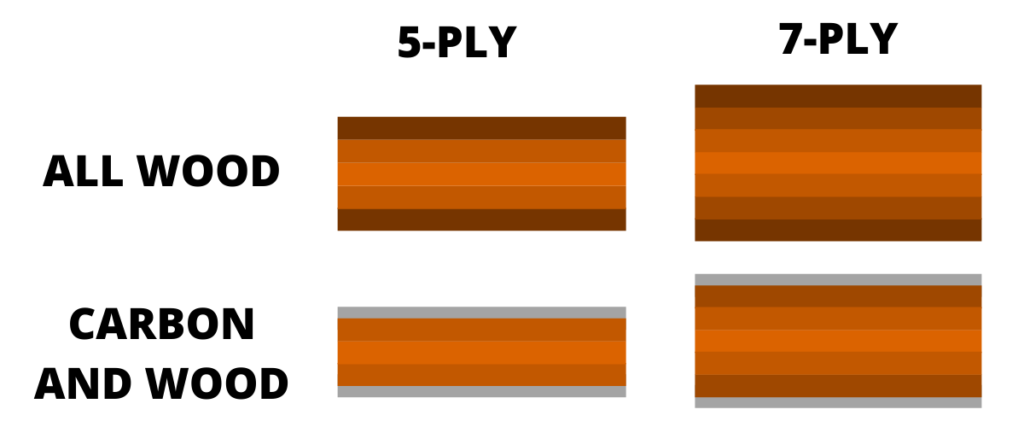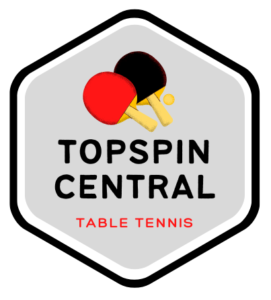Choosing a blade for short pimple rubber can be a little tricky as it’s difficult to know which type of blade is best. In this article, I’ll be explaining which types of blades are the most suitable for short pips (and the ones to avoid) and giving you some examples to consider.

Hardness and Stiffness
The two main characteristics of the blade that you need to consider are the hardness and the stiffness. These two factors are affected by the physical attributes of the blade (thickness and composition) and influence how powerful and easy to control the blade is.
It’s important to note that stiffness and hardness are not the same thing.
- The stiffness of the blade is influenced by the overall composition. This includes the thickness, type of materials used and the number of layers.
- The hardness of the blade is influenced by the outer layers. A blade that is considered soft-touch, will have a soft material on the outer layers.
So what effect does hardness and stiffness have on the blade’s performance?
Hardness
Harder blades feel more powerful and direct. This means that the player will not need to use as much force to make the ball move as quickly with a hard blade compared to a soft blade (assuming all other characteristics are kept constant).
Hard blades are good for short pips they tend to suit smashing, blocking and flat-hitting more than soft blades which is what most players who use short pimple rubbers are looking for. They are less suitable for looping because they are not as good at generating spin, but this tends not to be a concern for SP players.
Keep in mind that hard blades can sometimes be harder to control because they feel very powerful. It’s not necessary to go for a super hard blade, if this is your concern. However it is a good idea to avoid something very soft.
Stiffness
Stiffer blades are more powerful and hence faster than flexible blades. Flexible blades tend to suit players who want to apply a lot of spin because they increase the dwell-time that the ball has on the paddle. However, this is not really what a short pip player needs.
That’s why stiffer blades are generally more suited to short pimple rubbers because they feel more direct, stable and powerful. They suit counter-attacking players, blocking and flat-hitting.
Stiffer blades also feel more “dead”. This simply means that they do not vibrate as much in the players hand. This characteristic is often preferred by players who are flat-hitting more then they are looping.
Check out my guide to blade hardness and stiffness for more information.
Physical Characteristics of the Blade
Okay so now we know that harder and stiffer blades are generally better for short pimple rubbers, what kinds of blades should you look out for in terms of composition? Let’s consider the following physical attributes to clear this up:
- Thickness
- Number of layers
- Material (carbon or wood)
- Weight
Thickness
Thicker blades are better for short pimple rubbers because thicker blades tend to be stiffer and harder. This means they feel more powerful and stable as they tend not to vibrate as much. Most blades are around 5-7 mm thick and I recommend choosing something at least 5.8 mm thick for short pimple rubbers.
The thickness of the blade is dictated by the number of layers it has, and the thickness of each individual layer.
Number of Layers
Most table tennis blades have either 5 layers or 7 layers and are described as being either 5-ply or 7-ply blades. Assuming the layers are similarly thick, 7-ply blades are thicker than 5-ply blades. For the same reasons as described above, this makes them more suitable for short pimples compared to 5-ply blades.
It’s important to note that this is a general rule, and not absolute. It is still possible to get 5-ply blades which are thicker than 7-ply blades which muddies the waters a bit. This is because it also depends on the materials used and the thickness of each individual layer.
Check out my comparison between 5-ply and 7-ply blades for more info.

Material
Table tennis blades are typically made from wood or a combination of carbon and wood (composite blades). Wooden blades tend to feel softer and more flexible than composite blades. Hence, choosing a composite blade is a good option for short pimple rubbers.
Again, there are exceptions here though. It also depends on the number of plies and the thickness of the blade as well. It’s just another factor that we need to throw into the mix.
Here’s an article comparing wooden and carbon blades with more advice.
Weight
I wanted to quickly mention the effect of weight here as well. It tends to be that weight has an indirect effect on the blade’s hardness and stiffness. This is because the materials, number of layers and thickness of each layer effects the weight rather than the other way around.
Hence, it tends to be the case that heavier blades are better for short pimple rubbers than lighter ones indirectly.
One thing to be weary of with very heavy blades though is that they tend to slow the reactions of a player down because they make them feel a bit more sluggish compared to lighter blades. If you play close to the table then you may want to avoid a particularly heavy blade.
Here’s a guide to blade weight and why it actually matters.
Top Picks
Now we’ve been through the guidelines, let’s take a look at some of the best blades to pair with short pimple rubbers:
- Avalox P700
- Stiga Clipper
- Butterfly Timo Boll ALC
Avalox P700
Avalox P700 is well suited to short-pimple rubber and offers great control. It is moderately hard and stiff which means it’s not too soft for short pimples, but won’t feel too fast and difficult to tame.
- Composition: 7-Ply All-Wood
- Thickness: 6.2 mm
- Weight: 90 g
- Relative Hardness: Moderate
- Relative Stiffness: Moderate
Stiga Clipper
The Stiga Clipper is a touch thicker and hence harder compared to the option above. This means it feels a bit more powerful and faster but it’s still not too hard to control. It pairs very well with short pimple rubber if you’re looking for something that feels strong and stable.
- Composition: 7-Ply All-Wood
- Thickness: 6.6 mm
- Weight: 90 g
- Relative Hardness: Moderate
- Relative Stiffness: Moderate-Stiff
Check out the Stiga Clipper on Amazon.
Image links to Amazon
Butterfly Timo Boll ALC
The Timo Boll ALC is a very powerful blade. It’s a bit stiffer feeling than the previous two blades so can be a bit harder to control though and is best suited to more experienced players.
- Composition: 5+2 Ply ALC-Carbon and Wood
- Thickness: 5.8 mm
- Weight: 90 g
- Relative Hardness: Moderate
- Relative Stiffness: Moderate-Stiff
Check out the Timo Boll ALC blade on Amazon.
Image links to Amazon


